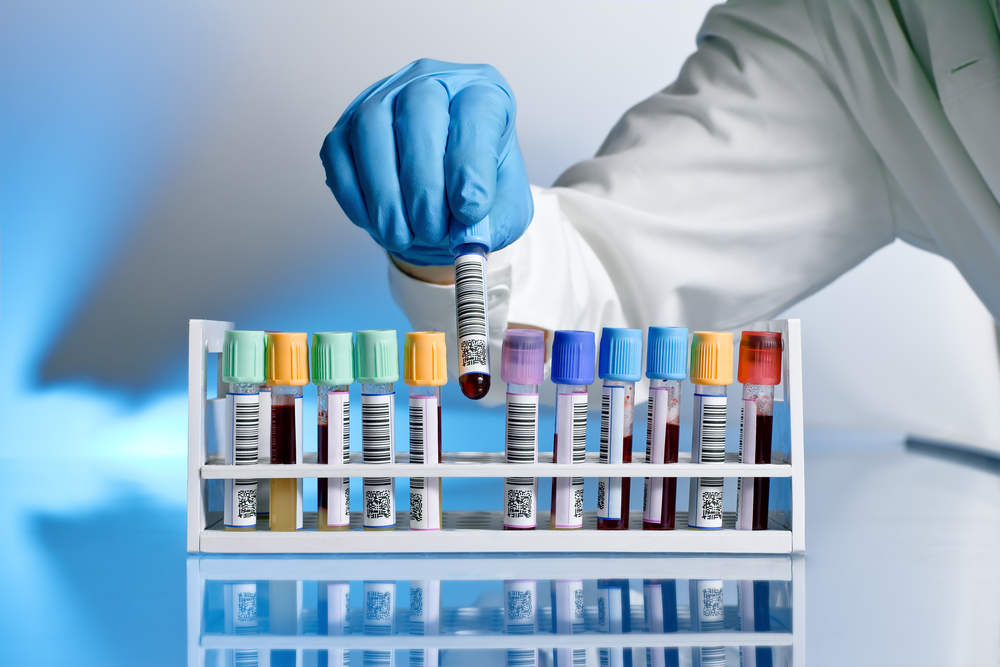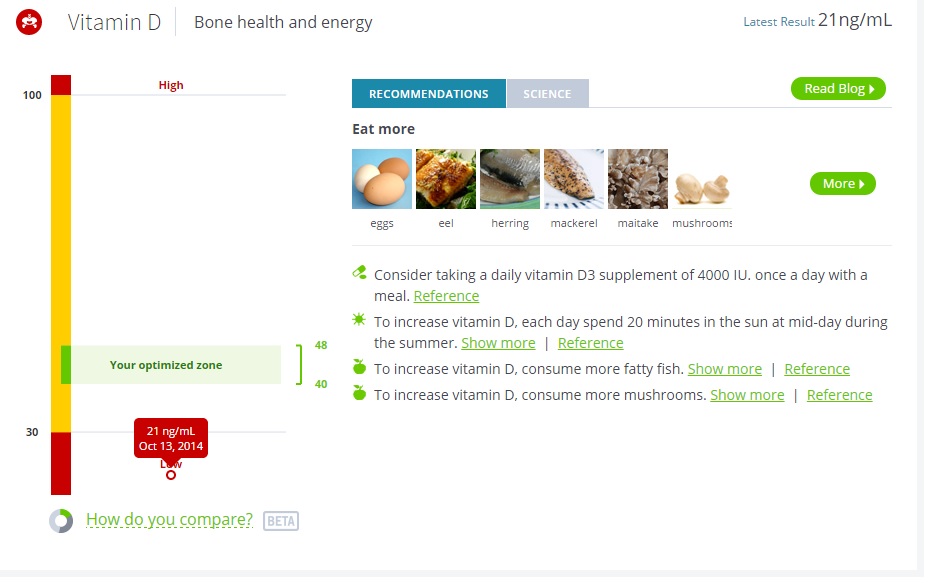'InsideTracker' Review: Can a Commercial Blood Test Make You Healthier?

InsideTracker is a service that analyzes your blood for various biomarkers — from sugar and cholesterol levels to liver enzymes — and tells you how you are faring in terms of health and fitness. The service does not intend to find disease, so users with an off-the-chart blood sugar level would not be told whether they may have diabetes, but instead would be advised to visit the doctor. But InsideTracker will recommend lifestyle changes to people within the "normal" ranges of the markers it looks at, so they can work to bring their blood markers up or down to what is "optimal" for them based on the latest research, the company says.
InsideTracker was founded in 2009 in Boston, and first offered its services to professional athletes. More recently, the company has been offering the services to anyone. [10 Fitness Apps: Which Is Best for Your Personality?]
To see how well the whole thing works, I tested this service. (InsideTracker provided the testing and results free of charge.) I reviewed my results as meticulously as I could, and I spoke with InsiderTracker's co-founder Gil Blander, a biology Ph.D., as well as with another expert who was not involved with the company. Here is what I found.
How the blood test works
For me, the blood test was easy: a nurse came to my office and drew my blood. But users can go to laboratories that have partnered with Inside Tracker to carry out their blood test.
People can also use existing blood work results and upload the data to InsideTracker, paying the service $50 for the analysis. Alternatively, people can opt for the service's other plans, which include the blood draw and test and range from $99 to $499 depending on the markers included in the test.
People can use the service a single time, and follow the recommendations, but they can also purchase the service again to repeat the test after a few months, to see whether their lifestyle changes (for example, eating healthier or taking certain supplements) have made a difference.
Get the world’s most fascinating discoveries delivered straight to your inbox.
A few days after getting my blood drawn, I got an email with a link to my results on InsideTracker. The results tell you the levels of each marker, plus how your results compare to the optimal zone for your age and gender and how well you compare to your counterparts.
What you learn from InsideTracker
There are now so many biomarkers that scientists test for that you actually couldn't safely submit the amount of blood needed to test them all at once. The science team at InsideTracker has chosen 30 biomarkers that it believes are the most relevant to healthy people, and that are also modifiable with lifestyle and diet changes, Blander said.
At the beginning, it was amazing to see an enormous amount of data about myself in one place. The website's interface was user-friendly, comprehensible and full of information about each biomarker.
The 30 biomarkers in the test belong to different categories. For example, those related to metabolism included sugar, cholesterol (both the "good" HDL and "bad" LDL types) and triglycerides. Other categories included liver function (with tests for liver enzymes), inflammation (white blood cells and several inflammation markers), electrolyte balance (sodium, potassium and zinc), bone and muscle health (calcium and vitamin D), and a few other categories.
InsideTracker lists your results for each biomarker, shows the normal range in yellow, the abnormal range (too low or too high) in red. The range that InsideTracker defines as "optimal" for you is depicted in green.
Based on your results, the service gives some recommendations. For example, if you are low on vitamin D, it recommends taking supplements, suggests some foods you might eat, and tells you to spend more time in the sun. For each biomarker, the website also explains why the nutrient is important, and what it does in the body.
"When you talk to your physician, he is looking at you and tries to see whether you are sick or not. We are trying to optimize," Blander said. "The first step is to look at each of the biomarkers that you have and to try to find what your optimal zone is," which the service does for each person, based on age, gender, ethnicity, the amount of alcohol consumed and other factors, he said.
From my results, I learned that I was in good shape in pretty much all of the categories, but my vitamin D and calcium levels and my transferrin saturation (TS) percentage (which reflects free versus bound iron in the blood) were outside my "optimal" range, even though they were still normal. Now what this all meant is a bit tricky.
How does knowing your levels help you with your health?
InsideTracker aims to keep a narrower window of what is considered "normal range" based on scientific findings, to help people reach the healthiest state. (But be aware that not everyone agrees that finding such a narrow window is always possible or even desirable.)
Blander said InsideTracker's scientists have worked to find out what the medical literature says about the optimal level of each biomarker for a person to be the healthiest and live the longest he or she can.
For example, having a blood sugar (glucose) level below 100 suggests that a person is not diabetic or even prediabetic, which is good. But he still may not be at the optimal level even though he is healthy, Blander said. "What we find by looking at the literature is that for someone in the age of 20, it's better for him to be below 80 in order to live the longest, while someone who is older, in the 50s, it might be OK to be below 85 or 87."
For me, vitamin D and transferrin saturation levels were not optimal, so I looked into them more closely.
For vitamin D, the National Institutes of Health says that a level anywhere between 20 nanograms/milliliter and 50 ng/mL is considered adequate for healthy people, whereas InsideTracker says the optimal zone is narrower, between 40 and 48 ng/ml. Mine was 21 ng/mL, lower than the "optimal zone," but still within the normal range. However, it was close enough to the NIH's cutoff level that I decided to follow InsideTracker's recommendations to try to boost my level.
My other flagged biomarker, transferrin saturation (TSAT), reflects the amount of available iron in the blood. For women, a normal TSAT is between 12 and 45 percent. My TSAT was 38 percent, so it was normal, but outside InsideTracker's optimal zone of 18 to 34 percent. A high TSAT could mean that a person is consuming too much iron.
I found a recent study that somewhat backed up InsideTracker's recommendation about this optimal zone. The study involved about 16,000 adults and found a link between having a TSAT lower than 17.5 percent or higher than 31 percent, and a greater risk of dying early.
How far can you push to optimize?
But critics say there is not enough data in the scientific literature to define such a narrow optimal zone for every biomarker. Moreover, there's not enough evidence that having a level within such an optimal zone is any better than the normal range when it comes to one's actual health. Even if some studies find a link (like the TSAT study above), the findings have to be replicated in other studies before being considered a fact.
For example, what if my vitamin D were 35 ng/mL, well above the NIH's cutoff level of inadequacy, but still lower than the optimal zone? Dr. Pieter Cohen, an assistant professor of medicine at Harvard Medical School and a general internist at the Cambridge Health Alliance in Boston, said that such small differences in vitamin D levels probably wouldn't change anything in someone's health.
"There is zero data that a level above 40 is better than a level above 35. There's no research that raising the vitamin D from 35 to 45 level has any actual effect on health," Cohen said.
Blander pointed to two studies that found links between dying early and very low or very high vitamin D levels. He said the InsideTracker determines the optimal ranges by considering "the effect of vitamin D levels on athletic performance along with the relationship between vitamin D and other factors important to overall performance and well-being."
In the scientific community there are still questions about what the optimal levels of vitamin D may be and which conditions may be linked to low vitamin D levels, Cohen said. "Vitamin D has been researched in depth for years, we still don't the answers to this question. It's completely presumptuous that an app is going to tell you what's right," Cohen told me.
Can't you just go to your doctor?
Some of the biomarkers tested by InsideTracker overlap with what a physician tests for during a routine checkup, but at InsideTracker, the results are looked at differently, with more focus on optimized health rather than just avoiding diseases, Blander said.
Other biomarkers that InsideTracker looks at are not typically tested by a physician unless there's a concern. For example, the service measures your levels of the sex hormone testosterone, vitamin B12 and an enzyme called creatine kinase, which can be a marker of muscle degradation due to overexercise.
But despite the different focus between a physician and the InsideTracker, Cohen said he thinks it would be a bad idea to trust the platform over a doctor.
"Why should a consumer trust an app that has a business model selling more of their product, as opposed to a physician who has a minimum of six years training to prepare to interpret vital results as relates to you individually?" Cohen said.
Moreover, some people may interpret their results incorrectly and think they are outside the normal range (as was the case for me, at my first glance). In general, such services have the risk of leading to anxiety, and needless cost for additional tests that are done out of unnecessary concerns, Cohen said.
"If you use this in a population level, I suspect it would do more harm than good, because it will lead to a lot of confusion — a lot of people thinking their levels are too high or too low — and lead to extra doctor visits," that aren't needed, Cohen said.
Bottom line
I greatly enjoyed learning so much about the state of my body. The blood work results were presented in the most readable way (as compared with your typical lab test results), and I found it empowering to have access to this information in a way that I could readily understand. For people who have fairly recent blood work, I believe the company's first purchase plan that uses that blood work and costs $50 is a reasonable way to try out the service.
However, I am generally very curious about human physiology and the functioning of my own body, and I follow new trends that aim at using data to enhance human health. Not all people are as interested in this topic as I am, so they might not enjoy having this much information.
Also, I took everything I read on my results with a grain of salt, and so should you if you decide to purchase a plan. I wouldn't bet my life on the claim that boosting my vitamin D or "optimizing" other biomarkers would necessarily change my life in a tangible way, but I would be willing to try.
Email Bahar Gholipour. Follow Live Science @livescience, Facebook & Google+. Originally published on Live Science.




